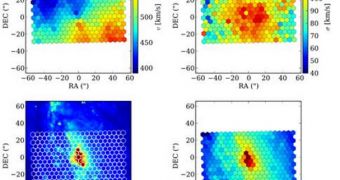Scientists at the Max Planck Institute for Extraterrestrial Physics (MPE) and the University Observatory Munich now have every reason to be proud – their new spectrograph was successfully installed on an American telescope, where it has already produced its “first light” study.
The VIRUS-W instrument is an imaging field spectrograph that is capable of producing no less than 267 individual spectra simultaneously. It is now mounted on the Harlan J. Smith Telescope, which is located at the McDonald Observatory, in Texas.
According to scientists, the instrument saw first light on November 10, 2010, but experts needed some time to process the data the uncalibrated instrument collected. The first object VIRUS-W saw was a large spiral galaxy, located some 30 million light-years away.
This photo was not taken for an intrinsic scientific value, but rather in order to assess the amazing capabilities of the new instrument. Its creators say that the spectrograph is capable of determine how fast stars in neighboring galaxies are moving.
The MPE crew argues that the instrument can do so with a high degree of precision, of just a few kilometers per second. This would make it one of the most precise science tool of its type ever made.
Studying the velocity distribution of the stars inside galaxies can help astronomers gain more insight into how galaxies develop, or into how stars behave once they are thrown out of binary star systems.
VIRUS-W can look at 267 spectra because it has 267 individual glass fibers. What a spectrograph essentially does is split light into its basic components. This procedure allows experts to identify particular chemicals in a star by looking at its light alone.
Various substances leave behind their individual signatures, experts say, and over the years astronomers have developed a catalog that contains most of the common chemicals and their equivalent in spectral readings, AlphaGalileo reports.
“When we attached VIRUS-W around midnight on the 10th of November to the 2.7m telescope, we were very happy to see that the data delivered by VIRUS-W was of science quality virtually from the first moment on,” MPE expert Maximilian Fabricius explains.
“As the first galaxy to observe we had selected the strongly barred galaxy NGC2903 at a distance of about 30 million light-years – right in front of our doorstep,” he adds.
“The data we collected reveal a centrally increasing velocity dispersion from about 80 km/s to 120 km/s within the field of view of the instrument,” the expert goes on to say.
“This was a very exciting moment and only possible because of the remarkable teamwork during the commissioning with a lot of support by the observatory staff!” Fabricius concludes.

 14 DAY TRIAL //
14 DAY TRIAL //